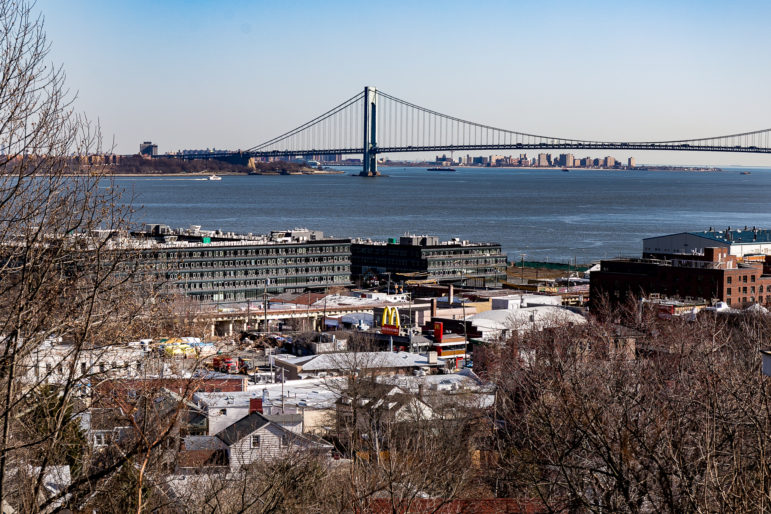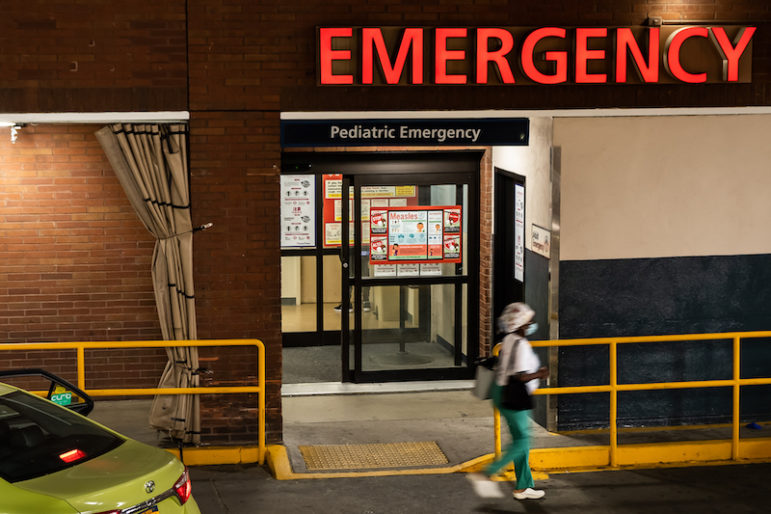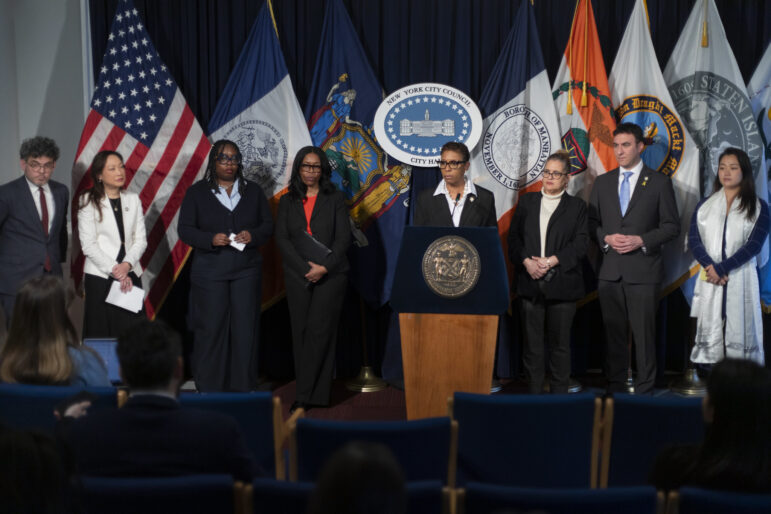The borough president’s bully pulpit stands especially high in Staten Island, separated from the rest of New York by seawater, demographics and a Republican orientation that could be getting firmer.

Adi Talwar
A view from Nixon Avenue on Staten Island towards Bay Street and the Verrazzano-Narrows Bridge.A mile of seawater separates Staten Island from Brooklyn at the Narrows, the closest point between Richmond County and the other four boroughs. By comparison, New Jersey is as close as 760 feet from Staten soil. Sometimes, those physical dimensions seem to map cultural differences: Staten Island often seems a lot closer to somewhere else than to New York City.
Like the other boroughs, Staten Island will elect a new borough president this year, and like every borough but Queens, it will be someone new, because of term limits. While the borough president’s authority isn’t what it used to be since a 1989 charter change stripped the post of voting power over the city budget and land use, the office retrains some statutory juice: BPs appoint community board members, monitor city services, control modest operating and capital budgets, and have an advisory voice in land-use review.
And the BP’s informal role as a spokesperson for the borough is amplified on Staten Island, where the office overlooks that expanse of harbor that separates it from the rest of the city.
Right now, City Councilmember Stephen Matteo and author and business owner Leticia Remauro are vying for the Republican nomination for borough president. History suggests Republicans will easily retain the Staten Island borough presidency, an office they have held since 1989—a reflection of one of the cultural differences between the island and the rest of the city.
But Lorie Honor, one of three Democrats in the borough president race or considering it, says she thinks the seat is winnable: “I don’t think it’s going to be as heavy a lift as people think.” Honor, a business owner and activist, says she is definitely in the race, as does civil servant and community advocate Radhakrishna Mohan. Realtor Mark Murphy is also said to be considering a run.
Over the past five elections, Democrats have never garnered more than 41 percent of the vote in a contest for borough president. The party received not quite a quarter of the vote in 2017. But that was when a daughter of the island—Nicole Malliotakis—was running for mayor, and before Max Rose showed a Democrat can win island-wide in 2018.
Man from the middle
Its nautical or cultural distance from the rest of the city notwithstanding, there’s also a pretty vast expanse of territory within Staten Island itself.
Thirteen miles long, it is the third-largest borough. The northern third has a poverty rate equal to the citywide average and a higher share of public housing than New York as a whole, and Democrats outnumber Republicans by nearly four to one. The South Shore has the highest homeownership rate and the smallest Black population of any community district in the city, and has the only Council district in New York with a Republican registration advantage.
The middle of the island is where this race will be decided, in an area that over the past 20 years has grown considerably more diverse—and somewhat more Republican. From 2000 to 2018, according to NYU’s Furman Center, the foreign-born population in the middle of Staten Island swelled from 18 percent to 30 percent, and the White population shrunk from 77 percent to 65 percent. The number of Democrats in mid-Island grew by 4,200 from 2011 to 2020, but Republican registration jumped by 7,400 in that time.
Matteo has more than half a million in his campaign account—more than 10 times what the next best-funded candidate can claim—and the advantage of having represented that mid-Island swing district in the Council since 2014, when he won the seat held by current BP James Oddo, to whom Matteo had been chief of staff.
He sees the office as a problem solver.
“The office I think takes on the personality of its holder and what I’ve wanted to do is what I’m doing in my district every day in terms of local issues. I wake up every day wanting to make Staten Island a better place.” Matteo often stresses the need for a “balanced approach.” Asked if ideology is important to the job, he says, “I think it matters to a point but it’s having that balanced approach and what I try to do even on the Council, it’s knowing when to negotiate, knowing when to push harder, knowing when to blast away an issue when you need it done.” He adds, “There’s no Democratic or Republican way to fix the pothole.”
A key role for the BP, he says, is making sure city agencies do their jobs, a task that “takes negotiation, and relationships.” Overall, it’s about pursuing incremental change. “To me, the big issues and the small issues blend into one another,” Matteo says. “I take an intersection-by-intersection approach. Take left-turn signals. That’s a small issue but it moves traffic effectively, and it’s safe. Obviously we need fast ferries. We need better bus service.” But if you get the little things right, he argues, you set the stage for bigger stuff, and you make life better even if the bigger stuff never comes to fruition.
Matteo brings up traffic issues for a reason: Transportation problems are a perennial woe on Staten Island, whether it’s getting to the rest of the city or navigating the island itself. These dovetail with the resistance to development: While many islanders want to preserve the low density and detached single-family houses that characterize many neighborhoods simply because they like that look, and some might resist more density for the flood of diversity it will bring, Staten Islanders also have legitimate concerns that the infrastructure across much of the borough is not built to handle large population gains.
“It’s talking about the right development,” Matteo says. “When you talk about development and housing, you have to talk infrastructure. That was one of my biggest concerns about the rezoning in the North Shore.” He voted against the 2019 Bay Street rezoning, where the de Blasio administration did promise infrastructure investments but, Matteo says, “I think they could have done more.”
Matteo doesn’t have much to say about race relations in the borough (“I think we all need to listen and hear each other and hear each others’ concerns”) and treads a careful line on whether secession is a viable option for Staten Island: “I completely understand the frustration. And the frustration is warranted because you have this one-size-fits-all approach from city leaders that is not benefitting Staten Island at all. But you have to do the study to see if it’s feasible. Cost is a huge part of this. Can we afford it?”
Choosing her words
Matteo is clear but cautious when it comes to the question every Republican gets asked these days: Was the 2020 election stolen from Donald Trump?
“The fact is the 2020 election has been through the legal process and settled by the courts. What we need to do as a party now is to look forward and continue to offer voters solutions that will improve their lives,” he said in a statement. “My focus is on using my experience in city government to help Staten Island recover from the past year.”
Asked the same question, Remauro appears less willing to acknowledge President Joe Biden’s legitimacy, and seems to suggest that the propriety of the results in 2021 might also be questioned.
“How elections are conducted and ensuring that election rules are consistently applied for all voters is a priority shared by Americans of all political leanings and should be on all our minds with the upcoming local elections,” she said in a statement. “Public officials and candidates should be focused on vaccinations, reopening our economy immediately and assisting small businesses in every possible way—all without political posturing.”
Asked whether she participated in the “Stop the Steal” rally in Washington last month, Remauro did not directly answer, but replied, “I did not attend President Trump’s speech nor was I inside the Capitol on January 6th.”
Remauro made the wrong kind of headlines later in January when she shouted “Heil Hitler!” at a rally against Gov. Cuomo’s pandemic restrictions on small businesses. Remauro has apologized for the remark. She meant to refer to the governor as “Mein Fuhrer” to draw a parallel between the governor’s emergency powers and the dictatorship of the Third Reich, a comparison she acknowledges is absurd.
Compared with Matteo, who stressed incremental, behind-the-scenes work, Remauro envisions an office that is more vocal than it has been under Oddo.“For Staten Island, because it’s the smallest borough, we’ve historically had to fight for everything that we get and the services that are offered back to us from the city are never enough to sustain us. In the past there’ve been very vocal borough presidents like Guy Molinari and Jim Molinaro who have pressed hard for us to even get basic services,” she says. “The BP really does have to get the mayor and the City Council to understand that we’re a different type of lifestyle because of the homeownership and the lack of transportation.”
Remauro believes her chief job would be to make the island more attractive for people to come or stay. “The way the city has historically acted is that, ‘It’s New York City! Everybody wants to be here,’ so we do what we want and we act with a lack of consideration for whether people want to live here.”
She wants to increase funding for the police department but scrap red-light and speed cameras. “They adopted the red light and speed cameras program and they reduced speed limits in certain areas” which was tough on “the people who have been living here and driving here and who have muscle memory in driving, and before you know it you’re socked with a speeding ticket for going 26 miles an hour.” She adds: “It’s unfair to seniors who’ve been driving for many years and have gotten used to a certain speed limit.” Instead, Remauro wants to install smart light technology to calibrate the timing of lights to traffic patterns.
A former Giuliani and Pataki administration member, and a one-time chairperson of Staten Island Community Board 1, Remauro now runs a public-relations firm. She’s criticized the way the mayor and governor have handled the impact of COVID-19 restrictions on small businesses. “The regulations that were put in place for restaurants were wrong. The city made arbitrary decisions about what percentage of space was safe to use,” she said, noting that a minority of COVID-19 cases with known, self-reported transmission paths could be traced to indoor dining.
In something of a break from conservative ideology, Remauro has called for a comprehensive plan of the entire borough. The idea is to prepare Staten Island to accept more population growth—not necessarily from newcomers, but from islanders who want to move out of mom and dad’s basement, or downsize to a smaller place as they age.
However, she makes clear that she envisions most new development being clustered in the north of the island. She wants “proper development in areas that are serviced by public transportation” like St. George. “At the same time we have to protect the upland and the communities that are mostly one- and two-family homes.”
All of Staten Island is relatively low density. The North Shore has 12,800 people per square mile—more than the 8,000/mile of mid-Island or 5,900/mile on the South Shore, but way less than, say, the 102,800 people per mile on the Upper East Side. Still, Remauro’s approach means areas on Staten Island that have already dealt with the pros and cons of more density—and which are also poorer and have more people of color—will get more of it, while the status quo is preserved in more fortunate neighborhoods.
“It’s not going to be fixed overnight,” Remauro says of the lack of transit infrastructure in the middle and south of the island. “So I think we should focus on the neighborhoods that make the most sense.”
‘It’s in my heart’
Murphy (who is not related to your correspondent) is the son of former Congressman John Murphy, and ran for Congress against Michael Grimm in 2012, losing 52-47 in a year when Staten Island narrowly went for Democrat Barack Obama over Republican Mitt Romney in the marquee matchup. He did not respond to interview requests, but a party insider says he is mulling getting into the race.
Mohan ran in the Democratic primary for the same Congressional seat in 2018, placing a distant fourth with 4 percent in the race Rose won. He says he’s better prepared this time, even if he is jumping into the BP contest a little late. A party activist for years, he’s served on two precinct councils, the board of his temple and a community board, among other work.
“I understand the political landscape of Staten Island and what needs to be done,” he says. “The job involves using Staten Island as a magnet for businesses. There’s a lot of opportunity to increase business and job creation. There’s a lot I can do to do the best for the community. I have been doing that. It’s something that’s in my heart.”
He believes his status as a board member of the state Public Employees Federation could open doors to the many union members on the island. “That’s something that’s in me. I want the labor union to be at the table,” he said. “The labor union helped me to stabilize and build my life. That is what gave me the scope and the rights that helped me to survive.”
Mohan points to the lack of a public hospital on Staten Island as an issue he’d emphasize if elected. He also sees transportation as a key topic. “I’ve been commuting to Manhattan for 29 years. I’ve used pretty much all the transportation options we have,” he said. “The biggest problem we have is to get to the ferry faster. There’s no one silver bullet for what we are facing here. With planning and working together with other leaders, we can get it done.” He wants more frequent ferry service to Manhattan (something new, faster ferries should help accomplish) as well as deeper consideration of a South Shore ferry stop that would allow people on the lower half of the island to avoid slogging to St. George.
Not a heavy lift?
Honor has never been a candidate for anything, but she was Rose’s outreach coordinator in 2018. “My status is I am definitely running,” she says. “I think that I’ve been sort of leading up to this job for the last 10 to 12 years.” During that time, besides the work for Rose, she ran a September 11 support group, co-founded Staten Island Women Who March to capitalize on energy from the 2017 Women’s March, opened a wine store and led activism around defending Obamacare and resisting ICE deportations.
Honor says the Staten Island borough presidency, and power in general, has been controlled by a fairly tight circle. Molinaro was Molinari’s deputy. Matteo was Oddo’s chief of staff, and now wants to succeed him a second time. “I don’t think that speaks to a more modern Staten Island that I see,” Honor says. “I would be a borough president who really reflects a different style to the outside world.”
She says the next BP’s first job would be to address the impact of COVID: on small businesses, on everyone’s mental state, and especially on women who have shouldered most of the burdens associated with kids’ learning remotely. That might require devoting funds for mental health support.
More broadly, “I like to think that the borough president’s role can be 100 percent customer service—a clearinghouse for all constituent services.”
“I’d love to develop transportation alternatives that take us a little bit away from our road use, our car use. I’d like to obviously see more people using public transit. I’d like to see roads that are improved for shared use with bikes, in particular, shared bikes,” she says. While she wants more bus rapid transit, she acknowledges that it’s a borough of drivers. Policy solutions have to be layered and flexible, but they’re needed now. “We do need more than studies.”
Like Matteo, Honor is skeptical of sweeping solutions. “There’s always this big idea in Staten Island that’s going to fix everything. I’d really like to make incremental changes that add up to something. One pothole at a time,” she says. “But once we’re done filling potholes, can we look for a greener alternative to filling potholes?”
Over the past 10 years, Democratic registration on Staten Island has grown by 10 percent, but the number of registered Republicans has jumped 31 percent. Democrats on the island are coming off an election where Rose was ousted, their hopes to pick up the Assembly seat Malliotakis was vacating were dashed, and their party chairman narrowly avoided an upset defeat. Honor has yet to report any fundraising. Yet she likes her chances.
“I know this community inside out. I have the character, personality, the drive, the relentlessness,” she says. “I’m extremely pragmatic. I think that combination of being realistic and pragmatic and also being broadly optimistic might be a new twist on politics.”










One thought on “Republicans Vie for Staten Island BP Nod as Democratic Challenges Take Shape”
You failed to mention the first black candidate to run for BP, Brandon Straford.